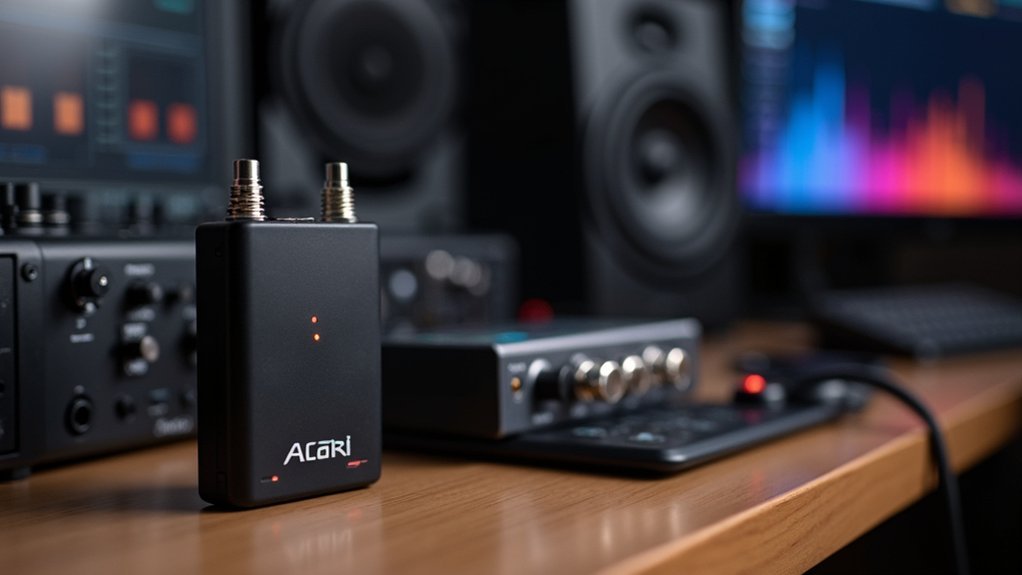You’ll revolutionize your production workflow with wireless VR headset management systems that provide real-time analytics, ultra-low latency motion tracking solutions under 10ms, and multi-user collaboration platforms for seamless team coordination. Essential tools include wireless audio transmission systems with automatic device discovery, VR content streaming applications requiring 25+ Mbps bandwidth, wireless camera integration leveraging Wi-Fi 6 technology, cloud-based rendering solutions, live performance capture tools, and network optimization utilities like AirMagnet for maintaining robust connectivity throughout demanding productions.
Wireless VR Headset Management Systems

When you’re deploying VR headsets across production environments, wireless VR headset management systems become essential tools that streamline device monitoring and performance tracking.
These systems provide real-time analytics on headset usage, battery life, and connectivity status, helping you optimize operational efficiency across your workforce.
Real-time headset analytics enable workforce optimization through comprehensive monitoring of usage patterns, battery performance, and network connectivity across your entire VR deployment.
Your reliable wireless infrastructure benefits from Wi-Fi 6 technology, ensuring low latency and high bandwidth for immersive training experiences.
You’ll gain robust security features including access control and monitoring that prevent unauthorized use while maintaining data protection compliance.
Integration with existing IT systems enables seamless updates and device management across multiple locations.
This wireless scalability enhances your VR applications’ effectiveness in industrial settings, allowing you to efficiently manage entire fleets of headsets from centralized control points.
Real-Time Motion Tracking Solutions
You’ll find that ultra-low latency tracking systems can monitor asset and personnel movement with millisecond precision, eliminating the delays that previously hampered real-time decision-making in your production environment.
When you implement seamless handoff technology, your tracking networks automatically transfer monitoring responsibilities between sensors as objects move through different zones, ensuring continuous visibility without data gaps.
These advanced capabilities let you respond instantly to workflow changes and maintain complete operational awareness across your entire facility.
Ultra-Low Latency Tracking
Although traditional tracking systems often struggle with delays that can disrupt critical operations, ultra-low latency tracking solutions deliver the real-time responsiveness your production environment demands. These Industrial Wireless systems achieve sub-10-millisecond latency, ensuring instantaneous data processing for dynamic manufacturing operations.
Cisco’s Ultra-Reliable Wireless Backhaul (URWB) technology provides seamless handoffs for moving assets through “make-before-break” procedures, eliminating data loss risks. This capability proves essential for AGV operations and high-density asset environments where continuous connectivity matters most.
| Feature | Traditional Systems | Ultra-Low Latency |
|---|---|---|
| Latency | 50-100ms | <10ms |
| Handoff Method | Break-before-make | Make-before-break |
| Data Loss Risk | High | Minimal |
| AGV Support | Limited | Optimized |
| Real-time Processing | Delayed | Instantaneous |
These wireless networks offer greater flexibility while enabling advanced automation and enhanced operational awareness throughout your production workflows.
Seamless Handoff Technology
Since moving assets require constant connectivity across your production floor, seamless handoff technology becomes the backbone of reliable real-time motion tracking solutions.
You’ll maintain uninterrupted connectivity as devices shift between access points, preventing costly data loss and latency spikes that could disrupt your operations.
This wireless network technology employs “make-before-break” protocols, establishing new connections before severing current ones.
You’ll experience enhanced reliability, especially when tracking Automated Guided Vehicles through manufacturing environments.
Your seamless handoff technology proves essential in high-density areas with RF interference, supporting multiple moving devices simultaneously.
Multi-User Collaboration Platforms

You’ll find that multi-user collaboration platforms transform your production environment by enabling real-time project coordination across all team members and departments.
These wireless solutions integrate seamlessly with your existing device management systems, creating a unified workflow that connects everything from tablets to industrial equipment.
What’s particularly valuable is their scalable team connectivity, allowing you to expand or contract your collaborative network based on project demands without compromising performance.
Real-Time Project Coordination
When multiple team members need to coordinate complex production tasks in real-time, multi-user collaboration platforms become essential wireless tools that transform how teams work together.
You’ll be excited to announce improved productivity as these platforms enable simultaneous document editing, instant task assignment, and progress tracking across your entire team.
Your wireless devices seamlessly integrate with project management software and design applications, eliminating the need to constantly switch between systems.
Cloud-based accessibility means you can coordinate effectively whether you’re on the production floor or working remotely.
Advanced security measures protect your sensitive project data while maintaining collaborative functionality.
These all-encompassing features streamline workflows, align team members on project goals, and guarantee a successful production outcome through enhanced communication and real-time coordination capabilities.
Device Management Integration
Three critical components define effective device management integration within multi-user collaboration platforms: automated discovery, centralized configuration, and real-time monitoring.
You’ll streamline your production workflow by leveraging platforms that automatically organize and configure networked devices, eliminating manual setup complexities.
Your team benefits from these essential capabilities:
- Batch Configuration Management – You can simultaneously edit multiple devices, reducing setup time and minimizing hardware configuration errors.
- Proactive Performance Tracking – Real-time alerts help you identify interference issues and connectivity problems before they disrupt operations.
- Enhanced Security Protocols – Protected access controls prevent unauthorized changes while maintaining data integrity across collaborative efforts.
These platforms guarantee seamless connectivity between team members while protecting your hardware investments through thorough monitoring and automated management processes in demanding production environments.
Scalable Team Connectivity
Modern multi-user collaboration platforms deliver scalable team connectivity that adapts to your production team’s evolving demands, supporting everything from small project groups to enterprise-level operations with hundreds of users.
You’ll maintain productivity through real-time communication and seamless resource sharing, essential for fast-paced production environments.
These platforms integrate with your existing enterprise applications, letting teams collaborate effectively without disrupting established workflows or requiring extensive training.
You’ll streamline operations using document sharing, video conferencing, and task management tools that keep everyone aligned on project goals and deadlines.
Enhanced security measures protect your sensitive production data, ensuring compliance while safeguarding intellectual property.
You’ll scale confidently as your organization grows, accommodating increasing users and devices without compromising performance or connectivity quality.
Wireless Audio Transmission Tools

Five key capabilities define today’s wireless audio transmission tools, transforming how you’ll manage audio equipment in production environments.
These platforms automatically discover networked devices, streamlining configuration while continuous scanning coordinates frequencies in real-time to minimize interference.
Smart network discovery and real-time frequency coordination eliminate manual setup headaches while automatically preventing interference across your entire wireless audio system.
Live monitoring becomes your production lifeline, tracking:
- Audio quality metrics – Real-time assessment of signal clarity and transmission integrity
- RF signal levels – Continuous monitoring of radio frequency strength and stability
- Battery status indicators – Proactive power management across all connected devices
Advanced batch editing and profile management let you configure multiple devices simultaneously, dramatically improving efficiency in complex setups.
You’ll appreciate seamless integration with existing communication systems, which enhances operational workflow and simplifies deployment across various production scenarios while reducing audio disruption risks.
VR Content Streaming Applications
You’ll need low latency streaming capabilities to guarantee your VR content reaches users without noticeable delays that break immersion.
Your network infrastructure must support high bandwidth demands, as VR applications require substantial data throughput for smooth visual experiences.
Real-time content delivery becomes critical when you’re managing interactive VR environments where user actions must trigger immediate responses.
Low Latency Streaming Requirements
When streaming VR content in production environments, you’ll need latency levels below 20 milliseconds to prevent motion sickness and maintain user immersion.
Real-time data transmission becomes critical since even minor delays disrupt the experience and reduce user engagement.
To achieve ideal low latency streaming, focus on these essential requirements:
- Wi-Fi 6 technology implementation – Delivers increased capacity and efficiency in dense device environments
- Minimum 25 Mbps bandwidth per user – Maintains high-resolution video and interactive content without lag
- Efficient frequency coordination – Minimizes RF interference from multiple connected devices
You’ll find that proper frequency management is particularly crucial when operating in environments with numerous wireless devices.
Without careful coordination, interference can quickly push your latency above acceptable thresholds, compromising the entire VR experience.
High Bandwidth Network Infrastructure
Modern VR content streaming applications demand robust network infrastructure capable of delivering at least 1 Gbps of throughput to maintain the high-quality, immersive experiences users expect.
You’ll need Wi-Fi 6 technology to greatly boost network capacity and performance, allowing multiple devices to stream simultaneously without quality degradation.
Consider implementing Cisco’s Ultra-Reliable Wireless Backhaul (URWB) for ultra-low latency under 10 milliseconds—critical when every millisecond affects user immersion.
You should deploy high-capacity access points designed for high-density environments to guarantee seamless connectivity and minimize interference.
Optimize your spectrum allocation by utilizing dedicated frequency bands and continuously monitoring RF conditions.
This approach helps you mitigate interference while maintaining stable, consistent streaming performance across all VR applications in your production environment.
Real-Time Content Delivery
Building on your high-performance network foundation, real-time content delivery becomes the backbone of successful VR streaming applications.
You’ll need ultra-low latency under 10 ms and exceptionally high bandwidth to maintain seamless user experiences during interactive sessions.
Your delivery system must handle three critical requirements:
- Dynamic connectivity management – Seamlessly shift users between access points without quality degradation
- Interference prevention – Deploy private 5G networks for dedicated bandwidth in high-density environments
- Real-time monitoring – Use tools like AirMagnet to identify and resolve connectivity issues instantly
Wi-Fi 6 and Ultra-Reliable Wireless Backhaul provide the throughput needed for multiple simultaneous HD streams.
You can’t afford interruptions when delivering VR content, so continuous network performance optimization guarantees your users maintain immersive experiences throughout their sessions.
Remote Device Monitoring Software
As production environments become increasingly complex, remote device monitoring software serves as your operational command center, delivering real-time visibility into every networked device across your wireless infrastructure. You’ll track critical performance metrics including audio quality, RF signal strength, and battery levels, enabling proactive management that prevents costly downtime.
| Feature | Capability | Benefit |
|---|---|---|
| Real-time Tracking | Audio, RF, battery monitoring | Proactive issue prevention |
| Alert System | Interference and hardware notifications | Minimized downtime risk |
| Batch Operations | Automatic device discovery | Streamlined configuration |
| Remote Access | Cross-subnet management | Enhanced connectivity control |
| Spectrum Analysis | Continuous frequency scanning | Optimized network performance |
You’ll receive configurable alerts for interference and hardware issues, while batch editing and automatic discovery streamline your workflow across challenging industrial environments.
Wireless Camera Integration Systems
Three critical challenges plague traditional wired camera systems in production environments: limited mobility, complex installation requirements, and vulnerability to physical damage from industrial operations.
Wireless camera integration systems solve these problems by leveraging Wi-Fi 6 technology for high-definition video transmission with minimal latency. You’ll benefit from real-time monitoring capabilities that enhance quality control and remote surveillance without cumbersome cables restricting placement options.
These systems deliver three key advantages:
- Seamless compatibility with existing industrial communication networks, ensuring smooth workflow integration.
- Remote access capabilities enabling stakeholders to view live feeds and recordings from any location.
- Rugged construction designed specifically for harsh manufacturing conditions, providing continuous operational reliability.
You’ll experience faster decision-making processes through cloud storage functionality while maintaining production efficiency in dynamic environments.
Cloud-Based Rendering Solutions
While traditional rendering workflows demand expensive hardware investments and lengthy processing times, cloud-based rendering solutions transform your production pipeline by delivering unlimited computational power on demand.
You’ll access scalable GPU resources without purchasing high-end local hardware, dramatically reducing your infrastructure costs through pay-as-you-go pricing models.
These platforms enable real-time collaboration, letting your team work simultaneously on projects from multiple locations.
Cloud rendering breaks down geographical barriers, empowering distributed teams to collaborate seamlessly on complex projects in real-time.
You’ll accelerate production timelines considerably, achieving faster iterations and quicker project delivery through vast cloud storage and processing capabilities.
Security remains paramount—cloud rendering services implement robust data encryption and user authentication to protect your sensitive assets and intellectual property.
This wireless approach revolutionizes how you handle complex 3D graphics and animations while maintaining professional security standards.
Live Performance Capture Tools
When live performances demand flawless audio execution, wireless capture tools deliver real-time monitoring capabilities that keep your production running smoothly.
You’ll gain instant visibility into audio levels, RF performance, and battery status across all channels, enabling immediate adjustments when issues arise.
The channel strip designer lets you customize monitoring displays for simultaneous multi-channel oversight.
Meanwhile, continuous scanning from networked devices creates detailed frequency plots, giving you extensive spectrum visibility for effective coordination.
Three key advantages enhance your workflow:
- Batch editing capabilities – Configure multiple wireless devices simultaneously for efficient large-scale setup
- Proactive alert systems – Receive configurable interference and hardware notifications before problems impact performance
- Real-time metering – Monitor audio, RF, and battery metrics per channel for instant troubleshooting
These tools guarantee your wireless systems maintain peak performance throughout demanding live productions.
Wireless Network Optimization Utilities
Beyond live performance capture, wireless network optimization utilities provide the analytical foundation for maintaining robust connectivity across industrial environments. Tools like AirMagnet and WiSpy Spectrum Analysis enable you to evaluate network performance precisely and identify interference sources that compromise connectivity.
You’ll benefit from automated monitoring capabilities that track device and access point performance in real-time. These tools help establish baselines and proactively address connectivity issues before they impact production. Intelligent wireless networks can dynamically adjust to physical obstacles and network failures, ensuring consistent coverage while minimizing dead zones.
| Feature | Benefit | Application |
|---|---|---|
| Real-time monitoring | Proactive issue detection | Baseline establishment |
| Batch editing | Streamlined management | Multi-device configuration |
| Spectrum analysis | Interference identification | RF optimization |
| Dynamic adjustment | Consistent coverage | Dead zone elimination |
| Frequency coordination | Performance maintenance | Interference minimization |
Frequently Asked Questions
What Are the Initial Setup Costs for Implementing Pro Wireless Tools?
You’ll typically invest between $500-5,000 initially, depending on your production scale. Basic wireless microphone systems start around $300-800, while professional multi-channel setups with monitoring equipment can reach $2,000-5,000 for extensive coverage.
How Do Wireless Tools Perform in Environments With Electromagnetic Interference?
You’ll experience reduced performance when electromagnetic interference disrupts wireless signals. Modern tools incorporate frequency-hopping technology and shielded components to maintain connectivity, but you should still minimize interference sources for peak operation.
What Backup Solutions Exist When Wireless Systems Experience Unexpected Failures?
You’ll need wired backup tools, redundant wireless channels, and manual override systems. Keep spare batteries, alternative communication methods, and hardwired connections ready. Train your team on quick switchover procedures for seamless changes.
Which Wireless Security Protocols Best Protect Sensitive Production Data?
You’ll want WPA3 encryption as your strongest defense, combined with enterprise-grade authentication protocols. Implement VPNs for data transmission, enable MAC address filtering, and use network segmentation to isolate sensitive production systems from potential threats.
How Often Should Wireless Equipment Be Upgraded for Optimal Performance?
You should upgrade wireless equipment every 3-5 years to maintain peak performance. However, you’ll need more frequent upgrades if you’re experiencing connectivity issues, security vulnerabilities, or when newer standards emerge.
In Summary
You’ve now got the essential wireless tools to revolutionize your VR production workflow. These solutions will streamline your content creation, enhance collaboration, and eliminate technical bottlenecks that slow down projects. Don’t let outdated wired systems hold you back—implement these wireless technologies to boost efficiency, reduce setup time, and deliver professional-quality results. Your production team will work faster, smarter, and more creatively with these powerful tools at your disposal.





Leave a Reply